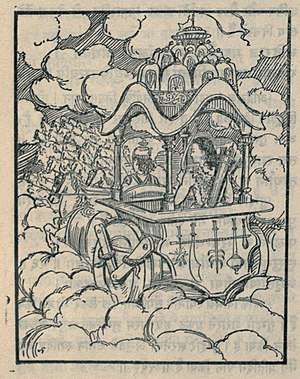Svarga
Swarga (Sanskrit: स्वर्ग), also known as Swarga or Svarga Loka, is one of the seven higher lokas (esoteric plane) in Hindu cosmology. The seven lokas consist of Bhuloka, Bhuvar loka, Svarga loka (Indraloka), Maharloka, Janaloka, Taparloka, Satyaloka.[1] While these seven lokas and seven patala lokas form 14 lokas of our Universe, beyond these 14 exist Goloka, Manidweepa and such higher lokas of multiple Universes.

Svarga Loka is a set of heavenly worlds located on and above Mt. Meru where the righteous live in paradise before their next incarnation. During each pralaya (the great dissolution), the first three realms, Bhu loka (Earth), Bhuvar loka and Swarga loka are destroyed. Below the seven upper realms lie seven lower realms, of Patala, the underworld and netherworld.[1]
Overview
Svarga is seen as a transitory place for righteous souls who have performed good deeds in their lives but are not yet ready to attain moksha, or elevation to Vaikunta, the abode of Lord Vishnu, considered to be the Supreme Abode (Rig Veda (1.22.20) states,
- "Oṃ tad viṣṇoḥ paramam padam sadā paśyanti sūrayaḥ"
- "All the suras (i.e., devas- divinities) look toward the feet of Lord Vishnu as the Supreme Abode"
The capital of Svarga is Amaravati and its entrance is guarded by Airavata. Svarga is presided over by Indra, the leader of the devas.
See also
References
- B. K. Chaturvedi (2004). Shiv Purana. Diamond Pocket Books. p. 124. ISBN 8171827217.
- The Garuda Purana (Wood and Subrahmanyam translation, 1911) at sacred-texts.com
